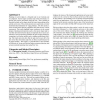Free Online Productivity Tools
i2Speak
i2Symbol
i2OCR
iTex2Img
iWeb2Print
iWeb2Shot
i2Type
iPdf2Split
iPdf2Merge
i2Bopomofo
i2Arabic
i2Style
i2Image
i2PDF
iLatex2Rtf
Sci2ools
AVI
2008
2008
Evaluation of pointing performance on screen edges
Pointing on screen edges is a frequent task in our everyday use of computers. Screen edges can help stop cursor movements, requiring less precise movements from the user. Thus, pointing at elements located on the edges should be faster than pointing in the central screen area. This article presents two experiments to better understand the foundations of "edge pointing". The first study assesses several factors both on completion time and on users' mouse movements. The results highlight some weaknesses in the current design of desktop environments (such as the cursor shape) and reveal that movement direction plays an important role in users' performance. The second study quantifies the gain of edge pointing by comparing it with other models such as regular pointing and crossing. The results not only show that the gain can be up to 44%, but also reveal that movement angle has an effect on performance for all tested models. This leads to a generalization of the 2D Ind...
| Added | 02 Oct 2010 |
| Updated | 02 Oct 2010 |
| Type | Conference |
| Year | 2008 |
| Where | AVI |
| Authors | Caroline Appert, Olivier Chapuis, Michel Beaudouin-Lafon |
Comments (0)

